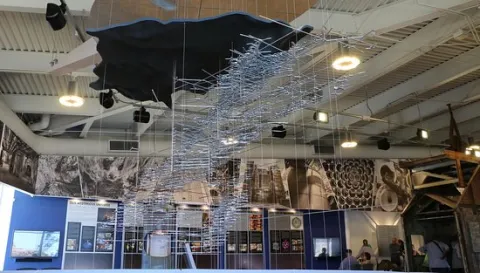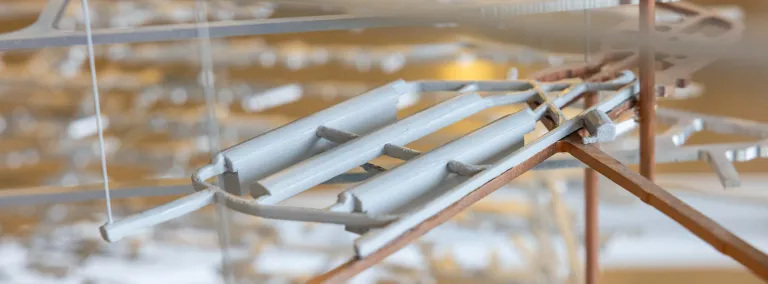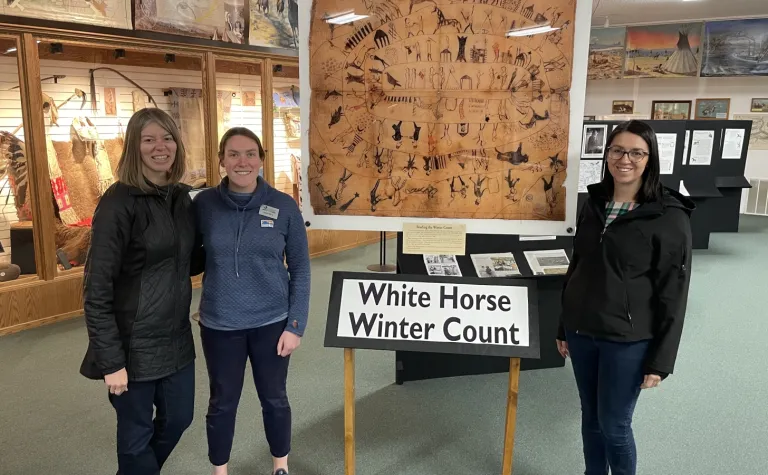New DUNE model at Sanford Lab Homestake Visitor Center adds perspective to colossal undertaking
The large model of the underground structure below Lead at the SURF Visitor Center now includes the newly excavated DUNE caverns.
A centerpiece of the Sanford Lab Homestake Visitor Center (SLHVC) in Lead is a towering three-dimensional model that includes the Open Cut and 370 miles of drifts, ramps, and shafts that make up the Sanford Underground research Facility (SURF). The large model helps convey the complexity and scale of the massive underground structure and myriad of interweaving tunnels that extend roughly 8000 feet below the town of Lead.
The model was made before the completion of the giant caverns at SURF for the Long Baseline Neutrino Facility / Deep Underground Neutrino Experiment (LBNF/DUNE). Doug Tiedt, a research scientist at SURF, decided to take on an upgrade to see the new DUNE expansion at SURF added to the model inside the visitor center.
Tiedt first came to Lead about five years ago during postdoctoral studies on the LUX-ZEPLIN dark matter experiment, and enjoys working on his own 3D printers at home. “This 3D print is something I figured was doable as a project for one of my normal quarterly goals,” said Tiedt.

Accurately modeling the DUNE caverns at SURF is not a straightforward task. LBNF/DUNE is the largest physics experiment ever undertaken on American soil. The DUNE caverns at SURF are located 4850 feet underground. They are mind boggling in size, around nine stories high, 65 feet wide, and a football field and a half long. The model helps visitors understand the scale of both DUNE and SURF.
To complete this task, Tiedt joined forces with Kyle Jankord, a technician at SURF who is an expert in Computer Aided Design (CAD). Jankord studied CAD at Western Dakota Technical College and has been a part of the engineering department at SURF for the past six years.
Tiedt and Jankord worked together to create the 3D printed scale model of DUNE.
“Kyle had much of the hard part. He had all the measurements and 3D computer models, and he came up with the numbers,” said Tiedt. “We took the computer 3D model of the DUNE caverns, and stitched it up to work for this application,” said Jankord. “Then we took measurements on the actual model in the visitor center and fit the DUNE 3D print to that scale,” Jankord adds. “It ended up working out nicely.”
Tiedt and Jankord used an iterative design process to get from the computer model to a final result.
“One challenge was getting it into the right software needed to slice the 3D computer image to get it to print the actual model, it was a lot of back and forth to get something that would work,” says Tiedt.
Thanks to their efforts, the DUNE caverns are now a part of the larger model that can be seen inside the SURF Visitor Center.
Like many models there is a little glue involved. “It’s actually super glued in place,” Tiedt said.
Visitors will need a keen eye to spot DUNE inside the SURF model. Despite being massive undertaking the DUNE caverns are dwarfed by the rest of the underground workings below the town of Lead. The upgraded model will help future visitors gain this new perspective.
“It’s interesting to see where it sits relative to the rest of the mine and seeing the scale of it, that something that massive was designed and built in this short of time is amazing,” says Jankord.


